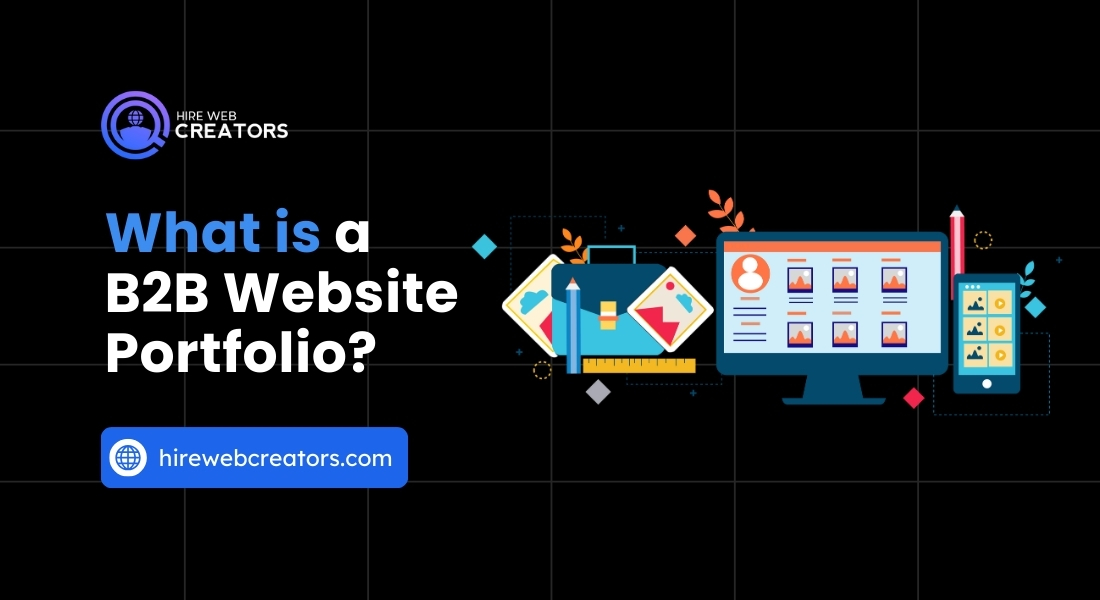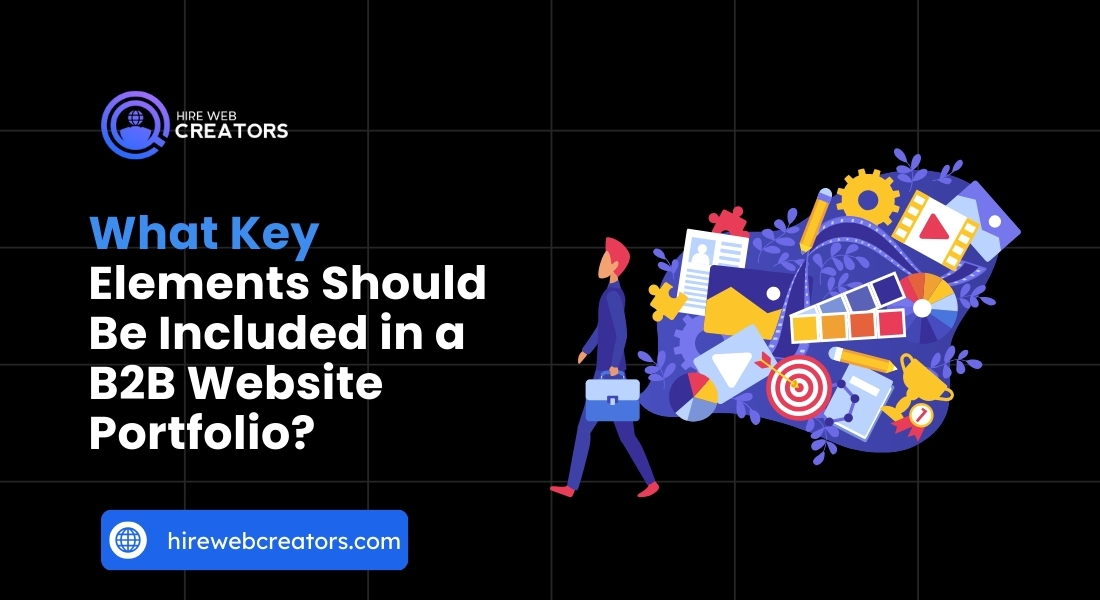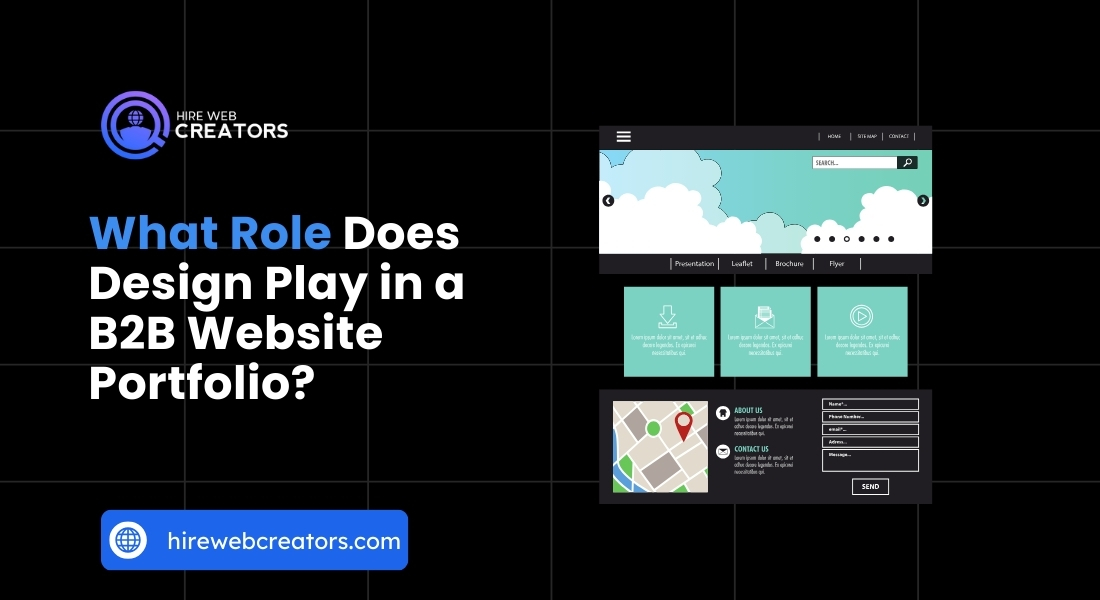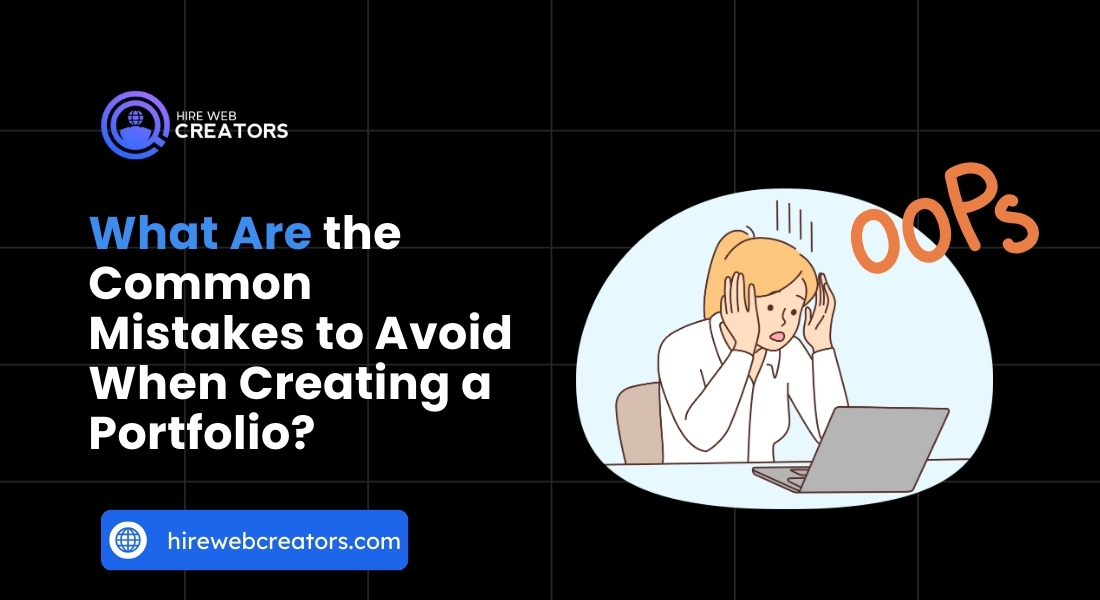

B2B Website Portfolio: 12 Ultimate Tips for Captivating Design
Unlock the secrets to crafting an effective B2B website portfolio that captivates clients. Elevate your business with proven strategies and expert insights!
The right B2B website portfolio in today’s competitive landscape is going to express and attract prospects to your expertise. A well-written portfolio represents more than the cream of your work; it speaks volumes about what your brand is all about and what it can do for clients, directly making this a mighty tool in your marketing repertoire.
A B2B website portfolio is not about the sharing of projects; it’s a strategy that talks to the target audience. If you know all the important constituents of a powerful portfolio, then you can be very effective at touting your prowess against competitors to acquire growth and success for your business.
What is a B2B Website Portfolio?
A B2B website portfolio is a curated collection of a business’s work that showcases its capabilities, projects, and achievements to potential clients. Unlike a traditional portfolio that may focus on a variety of services, a B2B website portfolio specifically targets the needs and interests of business clients, highlighting the effectiveness and quality of a company’s offerings in a business-to-business context. This focused approach enables businesses to effectively communicate their value propositions and demonstrate their expertise in solving specific challenges faced by their clients.

At its core, a B2B website portfolio serves several important functions. Firstly, it acts as a visual representation of a company’s skills and experience, allowing potential clients to assess the quality and relevance of previous work. Secondly, it provides an opportunity to illustrate how the company can meet the unique needs of other businesses. This is particularly vital in the B2B sector, where clients often seek proven results and a track record of success before making a purchasing decision.
In creating an effective B2B website portfolio, businesses should focus on the following key components:
- Showcase of Projects: Include detailed case studies and examples of previous work that highlight the processes and results achieved.
- Client Testimonials: Incorporate feedback from satisfied clients to build trust and credibility.
- Visual Appeal: Ensure the design is professional and reflects the brand’s identity while making it easy for visitors to navigate.
By incorporating these elements, a B2B website portfolio can effectively capture the attention of potential clients and communicate the value your business offers.
Why is a B2B Website Portfolio Important?
A B2B website portfolio plays a critical role in establishing credibility and trust with potential clients. In the competitive landscape of business-to-business services, clients are often inundated with options. A well-structured portfolio acts as a decisive factor in influencing their choice, providing tangible evidence of a company’s capabilities and expertise. When potential clients can see concrete examples of successful projects, it reassures them that your business can deliver the results they need.
The importance of a B2B website portfolio extends to enhancing your brand’s visibility and positioning within your industry. A thoughtfully designed portfolio not only showcases your best work but also reflects your brand’s personality and values. This representation is crucial for differentiating your business from competitors. A strong portfolio allows clients to understand not just what you do, but how you approach projects and the unique benefits you offer.
Having an effective B2B website portfolio can significantly impact your marketing efforts. By highlighting specific case studies and results, you can effectively communicate your value proposition to potential clients. Engaging storytelling and clear visuals within the portfolio help to create a memorable impression, making it easier for clients to recall your services when they are ready to make a decision. This capability to connect with your audience on a deeper level is invaluable in building long-term business relationships.
What Key Elements Should Be Included in a B2B Website Portfolio?
An effective B2B website portfolio should include several key elements that collectively showcase the strengths and capabilities of your business. First and foremost, high-quality project showcases are essential. These should feature detailed descriptions of the projects you’ve completed, including objectives, strategies employed, and the outcomes achieved. Highlighting specific metrics and results reinforces the effectiveness of your solutions, making your B2B website portfolio compelling and persuasive.

Another crucial component is case studies. Each case study should detail a particular project from start to finish, outlining the challenges faced and how your business addressed them. This narrative not only illustrates your problem-solving abilities but also helps potential clients envision how you can tackle similar challenges for their organizations. Including visual elements such as images, graphs, and charts can enhance these case studies, providing a more engaging experience for visitors.
Client testimonials and feedback should also be a prominent feature of your B2B website portfolio. Positive endorsements from satisfied clients add credibility and help to establish trust with prospective customers. Displaying logos of well-known clients or industry partners can further strengthen your portfolio, as it showcases your experience and the caliber of businesses you’ve worked with.
How Can You Showcase Your Projects Effectively?
Effectively showcasing projects in a B2B website portfolio requires a strategic approach that emphasizes clarity and engagement. Start by logically organizing your projects, allowing potential clients to easily navigate through the portfolio. Grouping projects by industry, service type, or project size can help visitors find relevant examples that align with their specific needs. This structured layout not only enhances user experience but also demonstrates your versatility across different sectors.
Visual storytelling is another powerful technique to showcase your projects. High-quality images, videos, and infographics can provide a visual context that enhances the written content of your B2B website portfolio. Each project should include a clear narrative that outlines the project’s goals, your approach, and the results achieved. Incorporating visuals that depict the project’s progression or outcomes can significantly enhance engagement and retention of information.
Lastly, consider integrating interactive elements such as clickable project showcases or slide shows. These features allow visitors to explore your work dynamically, making the experience more memorable. By employing a combination of clear organization, compelling visuals, and interactive elements, you can create a B2B website portfolio that effectively captivates potential clients.
What Role Does Design Play in a B2B Website Portfolio?
The design of a B2B website portfolio is critical in shaping the overall perception of your brand and services. A professional and polished design conveys credibility and competence, which are essential in the business-to-business sector. Potential clients are likely to associate the quality of your portfolio design with the quality of the services you offer. Therefore, investing in a clean, modern layout that aligns with your brand identity is crucial for making a positive first impression.

User experience (UX) design is equally important when creating a B2B website portfolio. A user-friendly interface ensures that visitors can easily navigate through your portfolio and find the information they need without frustration. Key design elements to consider include intuitive navigation menus, clear calls to action, and responsive design that adapts to various devices. A seamless UX enhances engagement, encouraging potential clients to explore your portfolio further and increasing the likelihood of conversion.
Incorporating consistent branding elements, such as color schemes and typography, throughout your B2B website portfolio reinforces your brand identity. A cohesive design not only improves the aesthetic appeal but also strengthens brand recognition. By prioritizing design and user experience, you can create a B2B website portfolio that not only looks professional but also effectively engages and communicates with your audience.
How Do You Write Compelling Case Studies?
Writing compelling case studies is essential for effectively showcasing your B2B website portfolio. A well-crafted case study provides a detailed account of a project, illustrating the challenges faced, the solutions implemented, and the results achieved. To start, it’s important to identify the most impactful projects that highlight your business’s strengths and capabilities. Focus on projects that resulted in significant outcomes or received positive feedback from clients.
The structure of a case study should typically include the following sections: Introduction, Challenge, Solution, and Results.
- In the introduction, provide context for the project, including client background and objectives.
- The challenge section should outline the specific problems the client faced.
- The solution segment should detail your approach and the strategies employed.
- The results in a clear and quantifiable manner, using metrics and testimonials where possible to substantiate your claims.
Visual aids, such as graphs and images, can enhance the readability of your case studies. They not only break up text but also provide visual evidence of your achievements. By focusing on clear narratives, structured formats, and visual elements, you can create compelling case studies that resonate with potential clients and strengthen your B2B website portfolio.
What Are the Best Practices for Organizing Your Portfolio?
Organizing your B2B website portfolio effectively is vital for maximizing its impact. A well-structured portfolio allows visitors to navigate easily, find relevant information, and appreciate the quality of your work. Start by categorizing your projects based on criteria such as industry, service type, or project size. This categorization helps potential clients quickly locate examples that align with their specific interests and needs.

Another best practice is to include a search function within your B2B website portfolio. This feature allows users to quickly search for specific projects or keywords, enhancing user experience and engagement. Additionally, consider implementing filters that enable users to narrow down their search results based on various attributes, such as project duration or results achieved. This level of organization demonstrates your commitment to user experience and makes it easier for potential clients to assess your capabilities.
Lastly, regularly review and update your B2B website portfolio to ensure that it reflects your most current work and achievements. Remove outdated projects that no longer represent your business’s capabilities and replace them with new, relevant examples. By maintaining an organized and up-to-date portfolio, you can present a clear picture of your expertise and effectively attract potential clients.
How Can Testimonials Enhance Your B2B Website Portfolio?
Client testimonials are a powerful tool for enhancing your B2B website portfolio. They provide social proof of your capabilities and create a sense of trust among potential clients. When prospective customers see positive feedback from satisfied clients, they are more likely to feel confident in choosing your services. Testimonials serve as endorsements that validate your expertise and the quality of your work.
To maximize the impact of testimonials, it’s important to feature them prominently within your B2B website portfolio. Consider placing them on the homepage, within relevant case studies, or as a dedicated testimonial section. Including client names, company logos, and specific details about the projects can further enhance the credibility of the testimonials. Authentic and detailed testimonials create a stronger connection with potential clients, making your B2B website portfolio more persuasive.
Encouraging clients to provide testimonials can be as simple as following up after project completion and asking for their feedback. Offering to feature their business in your portfolio in exchange for a testimonial can be mutually beneficial. By effectively integrating testimonials into your B2B website portfolio, you can build credibility, instill trust, and ultimately drive conversions.
What Are the Common Mistakes to Avoid When Creating a Portfolio?
Creating a B2B website portfolio requires careful attention to detail, as certain common mistakes can undermine its effectiveness. One of the most significant errors is failing to showcase your best work. Selecting projects that do not reflect the quality or diversity of your services can leave potential clients with a negative impression. Always prioritize projects that demonstrate your expertise and the results you can achieve for clients.

Another common mistake is neglecting to update the portfolio regularly. An outdated B2B website portfolio may feature irrelevant or old projects that no longer represent your capabilities. Regularly review and refresh your portfolio to include new projects and remove outdated examples. This practice not only keeps your content relevant but also signals to potential clients that your business is active and evolving.
Finally, poor organization and navigation can hinder the effectiveness of your B2B website portfolio. If potential clients struggle to find the information they need, they may leave your site frustrated. Ensure that your portfolio is well-structured, easy to navigate, and visually appealing. By avoiding these common pitfalls, you can create a B2B website portfolio that effectively showcases your strengths and attracts potential clients.
How Often Should You Update Your B2B Website Portfolio?
Updating your B2B website portfolio regularly is essential for maintaining its relevance and effectiveness. A good rule of thumb is to review your portfolio at least quarterly to assess which projects should be added, removed, or updated. This practice ensures that your portfolio accurately reflects your current capabilities and the most impressive examples of your work.
Incorporating new projects as you complete them is a critical aspect of keeping your B2B website portfolio fresh. Highlighting recent successes not only demonstrates your ongoing commitment to delivering quality services but also keeps potential clients informed about your latest work. Additionally, regularly updating project details, including metrics and results, can provide visitors with a clearer understanding of your business’s impact and effectiveness.
Lastly, consider collecting and incorporating new testimonials from satisfied clients during these updates. Regularly refreshing your B2B website portfolio with current testimonials and project examples reinforces your credibility and enhances your marketing efforts. By committing to frequent updates, you ensure that your portfolio remains a powerful tool for attracting new business.
What Tools Can Help You Build an Effective B2B Website Portfolio?
Leveraging the right tools can significantly enhance the quality and effectiveness of your B2B website portfolio. Content management systems (CMS) such as WordPress, Squarespace, and Wix offer user-friendly platforms for building and managing your portfolio. These platforms provide customizable templates and functionalities that make it easy to create a professional-looking portfolio without extensive technical knowledge.

Design tools like Canva and Adobe Spark can assist in creating visually appealing graphics and layouts for your portfolio. These tools allow you to produce high-quality images, infographics, and marketing materials that can enhance the visual appeal of your portfolio. Incorporating compelling visuals is crucial for capturing.
How to Present Case Studies in Your B2B Website Portfolio?
Case studies are a powerful tool for showcasing your business’s expertise and success stories. When presenting case studies in your B2B website portfolio, it’s essential to provide a clear and detailed account of the projects you’ve worked on. Start with an overview of the client’s problem, followed by the solution you provided and the results achieved. This structured format not only demonstrates your problem-solving skills but also builds credibility with potential clients. Incorporate visuals such as before-and-after images, infographics, and video testimonials to make your case studies more engaging and informative. Including micro-interactions in web design, such as hover effects on images or interactive timelines, can enhance the user experience by making the content more interactive and visually appealing.
It’s crucial to focus on the details that matter most to your target audience when crafting case studies. Highlight the specific challenges your clients faced and how your solutions directly addressed those issues. This demonstrates your ability to understand and meet the unique needs of your clients. Additionally, emphasize the measurable results of your work, such as increased revenue, improved efficiency, or enhanced customer satisfaction. These tangible outcomes serve as proof of your expertise and effectiveness. Utilizing micro-interactions in web design, like animated graphs or clickable case study summaries, can draw attention to key points and keep visitors engaged.
Moreover, it’s beneficial to include a diverse range of case studies in your portfolio to showcase your versatility and adaptability. Feature projects from different industries and of varying sizes to demonstrate your ability to handle a wide array of challenges. This broadens your appeal and shows potential clients that you have the experience and skills to meet their specific needs. Incorporating micro-interactions in web design, such as interactive sliders or accordion-style content sections, can make it easier for users to navigate through different case studies and find the information most relevant to them.
What Are the Essential Elements of an Effective B2B Website Portfolio?
Creating an effective B2B website portfolio requires the inclusion of several key elements that collectively showcase your business’s strengths and capabilities. Start with a compelling introduction that outlines who you are, what you do, and what sets you apart from the competition. This provides visitors with a clear understanding of your business from the outset. Next, feature a selection of your best work, including detailed case studies and client testimonials. These elements provide concrete evidence of your expertise and the positive impact you’ve had on your clients. Integrating micro-interactions in web design, such as animated transitions between sections or interactive project galleries, can enhance the overall user experience by making your portfolio more dynamic and engaging.
Another critical element of an effective B2B website portfolio is the inclusion of detailed project descriptions. For each project, provide a thorough account of the challenges faced, the solutions implemented, and the results achieved. This not only showcases your problem-solving skills but also provides potential clients with a clear example of how you can address their specific needs. Incorporating micro-interactions in web design, such as clickable project details or interactive infographics, can help to highlight key aspects of your projects and make the information more accessible.
Finally, an effective B2B website portfolio should include clear calls to action (CTAs) that guide visitors toward the next steps. Whether it’s scheduling a consultation, requesting a quote, or downloading a detailed case study, these CTAs should be strategically placed throughout your portfolio to encourage engagement. Utilize micro-interactions in web design, such as animated buttons or hover effects, to make your CTAs stand out and attract attention. Additionally, ensure that your contact information is easily accessible, providing multiple ways for potential clients to reach out to you. By combining these essential elements with thoughtful design and user-friendly navigation, you can create a B2B website portfolio that not only showcases your expertise but also drives conversions and business growth.
How to Effectively Showcase Client Testimonials in Your B2B Website Portfolio?
Client testimonials are a crucial component of a B2B website portfolio, as they provide social proof of your capabilities and the positive experiences of your clients. When showcasing client testimonials, it’s essential to highlight genuine and detailed feedback that reflects the quality of your work and your client relationships. Start by selecting testimonials that cover various aspects of your services, such as project management, technical expertise, and customer support. Display these testimonials prominently on your portfolio, using micro-interactions in web design, such as animated transitions or clickable testimonial sections, to draw attention and engage users. By featuring authentic and diverse testimonials, you can build trust with potential clients and demonstrate your commitment to delivering high-quality results.
In addition to text-based testimonials, consider incorporating multimedia testimonials, such as video interviews or audio recordings. These formats can provide a more personal and compelling account of your clients’ experiences. Videos, in particular, can capture the enthusiasm and satisfaction of your clients in a way that text alone cannot. Utilize micro-interactions in web design, such as interactive video players or animated testimonial quotes, to make these multimedia testimonials more engaging and accessible. By offering a variety of testimonial formats, you can appeal to different types of users and provide a richer, more immersive experience that highlights the positive impact of your work.
Furthermore, it’s beneficial to regularly update your testimonials to include feedback from recent clients. This not only keeps your portfolio current but also shows potential clients that you are actively delivering value and maintaining strong client relationships. Encourage satisfied clients to leave detailed testimonials by providing them with prompts or questions that guide them in sharing their experiences. Incorporate micro-interactions in web design, such as dynamic testimonial carousels or hover effects, to keep the content fresh and engaging. By continually adding new testimonials and utilizing interactive design elements, you can create a dynamic and persuasive section of your B2B website portfolio that effectively communicates the reliability and excellence of your services.
In conclusion, creating an effective B2B website portfolio is a crucial step in showcasing your business’s strengths and attracting potential clients. By thoughtfully including key elements such as project showcases, case studies, and client testimonials, you can build a portfolio that not only highlights your expertise but also resonates with your target audience. The strategic organization and design of your portfolio play significant roles in enhancing user experience, ensuring that visitors can easily navigate and appreciate the quality of your work.
Regularly updating your B2B website portfolio ensures that it remains relevant and reflects your most current achievements. By avoiding common pitfalls and leveraging the right tools, you can create a compelling and authoritative portfolio that positions your business for success in the competitive B2B landscape. Ultimately, a well-crafted portfolio is not just a collection of your work; it is a powerful marketing asset that can open doors to new opportunities and foster long-term client relationships.
